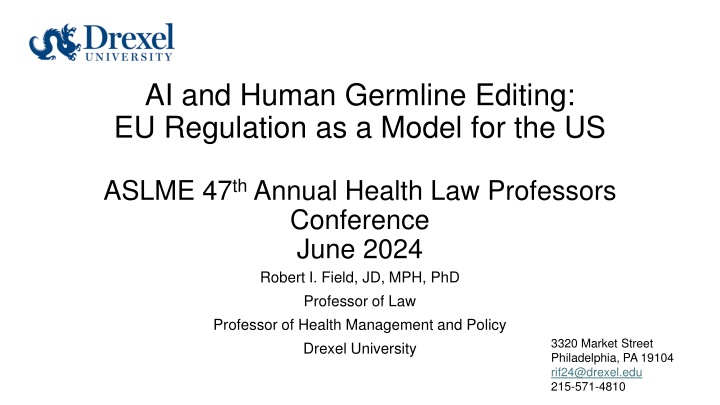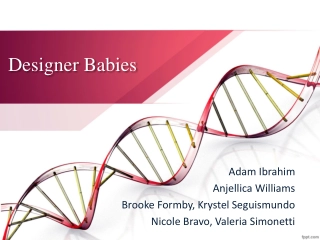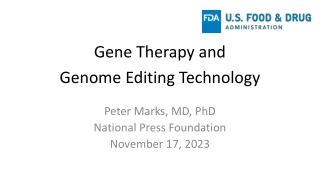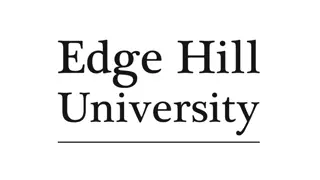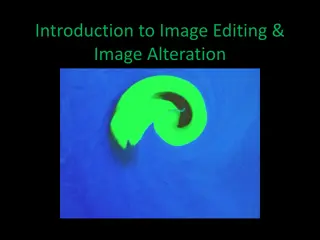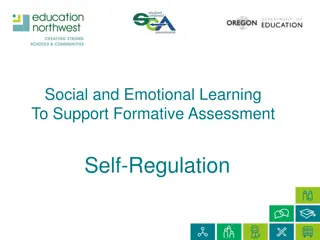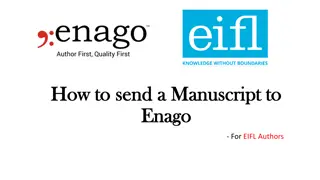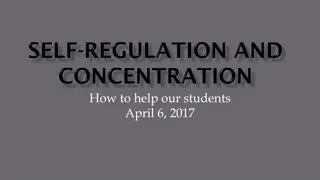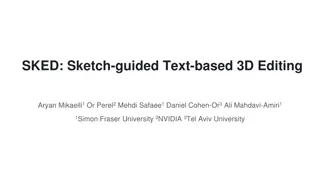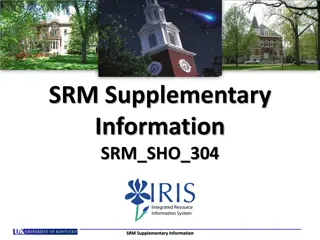AI and Human Germline Editing: EU Regulation as a Model for US
This presentation delves into the prospects, risks, and regulations surrounding AI and gene editing, focusing on germline editing, both natural and artificial. It discusses the implications of gene editing on somatic and germline cells, highlighting the promise of therapies for previously untreatable conditions. The content explores the intersection of AI with human germline editing, drawing comparisons between regulatory frameworks in the US and EU.
Download Presentation

Please find below an Image/Link to download the presentation.
The content on the website is provided AS IS for your information and personal use only. It may not be sold, licensed, or shared on other websites without obtaining consent from the author.If you encounter any issues during the download, it is possible that the publisher has removed the file from their server.
You are allowed to download the files provided on this website for personal or commercial use, subject to the condition that they are used lawfully. All files are the property of their respective owners.
The content on the website is provided AS IS for your information and personal use only. It may not be sold, licensed, or shared on other websites without obtaining consent from the author.
E N D
Presentation Transcript
AI and Human Germline Editing: EU Regulation as a Model for the US ASLME 47thAnnual Health Law Professors Conference June 2024 Robert I. Field, JD, MPH, PhD Professor of Law Professor of Health Management and Policy Drexel University 3320 Market Street Philadelphia, PA 19104 rif24@drexel.edu 215-571-4810
Outline Germline editing - prospects and risks AI and gene editing AI regulation in the US and EU Proposed approach
Natural Germline Editing - Viruses Natural germline editing viruses Retrovirus inserts DNA into sperm or egg cell 8% of human genome estimated to comprise such genes Most are inactive Some have been evolutionarily significant Memory formation 400 million years ago - gene codes for tiny protein bubbles that move information between neurons Placenta 100-200 million years ago - permits exchange of nutrients and waste without triggering mother s immune response Undoubtedly, countless deleterious genes were not replicated
Artificial Gene Editing CRISPR/Cas 9 Fast, efficient Higher precision than previous techniques Editing somatic cells, sperm, oocytes, embryos Possible uses for many monogenetic conditions Huntington s disease, thalassemia Genetic infertility But not for polygenetic conditions in the foreseeable future
Gene Editing Somatic vs. germline Somatic modify genetic makeup of somatic cells of an individual Germline modify genetic makeup of germ cells passed on to future generations Preimplantation In utero Long-term consequences unknowable
Germline Editing Promise Therapies for previously untreatable conditions Sickle cell disease treatment recently approved Therapy successful in an early phase study for CEP290-associated inherited retinal degeneration Therapy successful to restore hearing in two children with otoferlin gene-associated hearing loss Viable embryos produced with correction of MYBPC3 mutation cardiomyopathy Simpler than preimplantation genetic diagnosis (PGD) Healthier overall population Asian Bioeth Rev. 2018 Jul; 10(2): 133 141. Published online 2018 Jul 16. doi: 10.1007/s41649-018- 0056-x
Germline Editing Unique Risks Irreversible harm passed on to future generations Short and long-term effects impossible to predict
Germline Editing Mistakes Genetic risks Off-target effects - DNA cut at wrong site Translocations, inversions, large deletions
Germline Editing Mistakes Mosaicism
Germline Editing Genetic Risks Genetic vulnerabilities created by new gene or advantages lost Sickle cell anemia and malaria Cystic fibrosis and severe diarrheal diseases Tay-Sachs and TB Gene SLC39A8 decreases risk of hypertension and Parkinson s disease and increases risk of schizophrenia, Crohn s disease and obesity
Germline Editing Social Risks Reinforce inequality especially for enhancement Discrimination Global disparities Eugenics? What is a desirable trait? Cost to health system Procedure itself and amelioration of harms
Germline Editing Ethical Risks Enhancement vs. therapy Humans as engineered products Violating common heritage of humanity Research destroying embryos Created for research vs. extras from IVF 14-day rule in UK Prohibition of funding in EU and US Effect of fetal personhood laws
U.S. Germline Editing Law Clinical applications prohibited Limits on federal funding for research FDA position The idea of germline gene therapy is controversial. While it could spare future generations in a family from having a particular genetic disorder, it might affect the development of a fetus in unexpected ways or have long-term side effects that are not yet known. Because people who would be affected by germline gene therapy are not yet born, they can t choose whether to have the treatment. Because of these ethical concerns, the U.S. Government does not allow federal funds to be used for research on germline gene therapy in people. No limits on private research funding
International Germline Editing Regulation Prohibition of clinical use in about 30 countries Precautionary principle research permitted with restrictions WHO position To help ensure heritable human genome editing does not proceed prematurely to clinical trials, the Committee recommended, and the WHO Director-General subsequently made, a policy statement in July 2019 clarifying that it would be irresponsible at this time for anyone to proceed with clinical applications of human germline genome editing. Human Genome Editing: Position Paper (2021), https://iris.who.int/bitstream/handle/10665/342485/9789240030404- eng.pdf?sequence=1 NASME/Royal Society position Extensive national and international dialogue is needed before any country decides whether to permit clinical use of this technology, according to the report, which identifies essential elements of national and international scientific governance and oversight. Heritable Human Genome Editing (2020). https://nap.nationalacademies.org/read/25665/chapter/1#xiv
Known Violation: Twins in China Dr. He Jiankui, 2018 HIV immunity Modified CCR5 gene also related to brain function Higher risk of West Nile virus and severe flu Incomplete edits in one twin Proof of edits never presented Violated Chinese restrictions JBRA Assist Reprod. 2019 Jul-Sep; 23(3): 197 199. doi: 10.5935/1518-0557.20190042; https://www.ncbi.nlm.nih.gov/pmc/articles/PMC6724388/
International Germline Editing Consensus International collaboration of genetic specialists statement in wake of Chinese twins We call for a global moratorium on all clinical uses of human germline editing that is, changing heritable DNA (in sperm, eggs or embryos) to make genetically modified children. To be clear, our proposed moratorium does not apply to germline editing for research uses, provided that these studies do not involve the transfer of an embryo to a person s uterus. It also does not apply to genome editing in human somatic (non-reproductive) cells to treat diseases, for which patients can provide informed consent and the DNA modifications are not heritable. 567 Nature 165 (2019). file:///Users/rif24/Downloads/d41586-019-00726-5.pdf
AI for Gene Editing: Game Changer Large language machine learning Challenge of reviewing huge amounts of data to find genes, model cellular effects Human genome 20,000 genes, 3 billon base pairs Search for small mutations and random errors Search for sequences in microorganisms from around the world Big data now available on genes, RNA, proteins, DNA modifications Can train on databases containing billions of genetic sequences, including open- source databases Predict likelihood of successful gene editing based on patterns observed in previous cases Select optimal editing strategies Select best delivery strategy Post-therapy, permits real-time monitoring and assessment of patients Recent research can narrow databases to genetic sequences similar to known Crispr systems Six Crispr systems with different Cas proteins
AI and Gene Editing: Applications Chat GPT for genes Protein language model trained on millions of protein sequences to design Crispr gene-editing proteins https://www.nature.com/articles/d41586-024-01243-w Designing guide RNA (gRNA) to target genetic sequences Longer base sequences (32 instead of 20) for more precision, possibly fewer errors Finding new RNA targets Some gRNAs can disrupt almost all alleles in a cell population; others have no observable efect Predicting the risk of complex genetic diseases from genome-wide maps Identifying genetic differences between tumor and normal cells Analyzing complex genetic interactions involving epigenomics, proteomics, and metabolomics Fusing DNA sequences with Crispr/Cas nucleases with epigenetic modifying
AI and Gene Editing: Applications Create off-target prediction algorithms Designing gene editing experiments Conversion of individual nucleotides without requiring double-stranded breaks Precision medicine identifying genetic variations associated with diseases and predicting patient s response to treatment
AI regulation in the U.S. Biden executive order (October 30, 2023) General Develop and implement repeatable processes to understand and mitigate AI risks to biosecurity, cybersecurity, national security, and critical infrastructure Developers must share safety test results with government Government will develop standards, tools and tests to make sure AI systems are safe Protect against use to engineer dangerous biological materials Develop protections against AI-enabled fraud Develop an AI cybersecurity program Evaluate use of AI in criminal justice and federal programs Research potential workforce disruptions Measures to attract AI talent to the US Privacy Evaluate privacy risks Support for privacy-protecting research Evaluate how agencies use commercially available information Develop guidelines for evaluating privacy-protecting technologies
Legislative Action Bipartisan consensus that legislation is needed Proposals on election integrity, political ads, deep fakes, workforce and training, transparency of AI replacing humans National Security Block Nuclear Launch by Autonomous Artificial Intelligence Act (S. 1394/HR 2894) on federal funding for AI-based launch systems Congressional hearings but no comprehensive proposal yet
Federal AI Legislation AI Accountability Act - HR 3369 (118th Congress) Directs NTIA to study accountability measures for AI systems and report on trustworthiness and accountability Public meetings to solicit stakeholder input Senate proposal under development Funding for research and new regulation https://www.congress.gov/bill/118th-congress/house-bill/3369
Federal AI Legislative Proposal Center for AI Policy Responsible Advanced Artificial Intelligence At of 2024 Establish federal AI regulatory administration Hardware monitoring, analysis, and reporting of AI systems Civil and criminal penalties for misused Emergency power to address imminent threats Whistleblower protections https://www.aipolicy.us/work/model-legislation-release-april-2024
Proposed State Legislation CT inventory of all systems used by state agencies LA- resolution to study impact on government operations MD grants to assets small businesses in implementing technology ND person does not refer to AI systems TX establish AI advisory council
AI regulation in the EU Artificial Intelligence Act Four levels of risk Minimal Limited minimal transparency rules High registered in EU database Critical infrastructure Education and vocational training Employment management Essential private and public services Law enforcement Migration Interpretation and application of law
EU Artificial Intelligence Act Unacceptable prohibited Cognitive manipulation Social scoring Biometric identification Realtime remote biometric identification (facial recognition)
Proposal Implement EU model for risk-based regulation in the U.S. Classify AI for germline editing research as high ; for clinical applications as unacceptable Enforcement by DOJ, FDA, and NIH
Enforcement Challenges Global harmonization and rouge nations Arms race among nations Enforcement and penalties
Conclusion Humans should edit genes more ethically than viruses have
